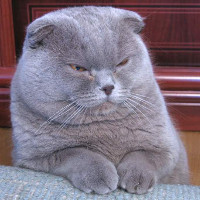|
A brief historical overview
|
The first known specimen of a cat with folded ears is Susie, a cat living on a farm north of Dundee in Scotland. She was discovered in 1961 by William and Mary Ross. A little later, the couple acquired Snook, a female kitten of Susie's also with folded ears. Snook was crossed with a red tabby alley cat and gave birth to kittens with folded ears, which were registered in 1966 with the Governing Council of the Cat Fancy (GCCF) by the Rosses1, aided by geneticist Pat Turner.
Despite geneticist Peter Dyle's conclusions outlining breeding recommendations for raising healthy cats with no health problems, the Governing Council of the Cat Fancy (GCCF) assumed in 1971 that folded ears could lead to deafness, and decided to no longer recognize the Scottish Fold in the UK. Some Fold cats were indeed found to be deaf, but it was later concluded that this deafness was caused by the White gene, not the Fold gene. The White gene is known to increase the risk of deafness when homozygous. Mary Ross had her cats sent to the United States, where local breeders took over, the Scottish Folds' round mine bringing them much success in America. Scottish Folds were recognized by the ACA in 1973, and by the ACFA and CFA in 1974. TICA was the first to recognize Highland Folds in 1988.
They crossed one of Snook's kittens with a British Shorthair to keep a brevilinear morphology, and gave birth to the scottish folds breed. From Susie's first litters, long-haired cats appeared, and took the name Highland Folds. In France, in the early 90s, the first Highland Folds were born in Perpignan at the home of Michel Bigas, founder of the European Scottish Fold and Highland Fold Club. |
Behavior / characteristics
|
Character traits are not described in the standards, but are temperaments generally observed in the breed.
The Scottish Fold is said to have a calm, rather quiet temperament, but is also very playful and enjoys playing with its owner. They are also said to enjoy the company of other dogs. |
Health
|
The gene causing ear folding in the Scottish Fold, when homozygous (which is forbidden in breeding), can sometimes lead to the development of a constitutional bone and cartilage disease called osteochondrodysplasia. Only homozygous Scottish Folds can be affected by the disease, which is why it is forbidden to cross 2 Scottish Folds together. In practice, we cross a Scottish Fold with a Scottish Straight, or with any other authorized breed.
Osteochondrodysplasia leads to disabling osteoarthritis, affecting Scottish Folds at a much younger age than other cat breeds. The first symptoms can appear as early as seven weeks of age.
Affected cats can be enormously deformed, with short, wide limbs and a short, stiff tail. They show claudication, swollen carpal and tarsal joints, an abnormal gait and are reluctant to move and jump. Severely affected individuals become paralyzed and unable to walk. Many affected cats are euthanized due to the profound effects of the disease.
In 2003, Lorraine Shelton, a specialist in genetic diseases, offered to pay for 300 x-rays of healthy Scottish folds to prove that the disease was not present in some heterozygous cats. Not a single breeder accepted this offer.
In 2008, the Journal of Small Animal practice published an article on diseases and disorders associated with certain breeds of cat. In this article, the author mentions the Scottish Fold, whose genetic mutation causing ear folding results in the appearance, to varying degrees of severity, of bone and joint peculiarities. The author takes issue with the fact that, although two breeding federations have refused to recognize the breed (FIFé and GCCF), the Scottish Fold is still bred to become a pet, admittedly a cute one, but probably doomed to suffer from arthritis in the more or less long term. |
Genetics
|
It has been established since the 1960s that the mutant gene responsible for folded ears is dominant.
While folded ears do not cause deafness, it is known that the gene responsible for folded ears, when homozygous (marriage of a Fold and a Fold), can sometimes cause calcifications, leading to paralysis of the tail and legs. For this reason, it is forbidden in many countries to cross Scottish Folds, and they are preferred to be bred with closely related breeds: the British Shorthair or Scottish Straight (its direct equivalent, minus the folded ears) in Europe, and the American Shorthair in the United States. |
|







 English (United Kingdom)
English (United Kingdom)